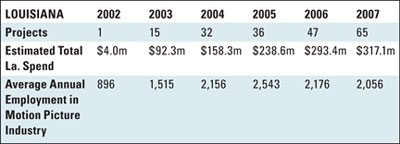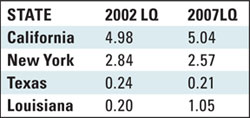
President,
taxadvantagegroup
uring periods of economic crisis, some states take the approach of expanding incentive programs to further enhance job creation, such as Alabama’s Act 2009-722 that offers existing incentives to a variety of white-collar industries; while other states limit incentive programs to better manage budgets, such as Iowa’s F 483, which caps a variety of existing tax credits. Regardless of the approach, incentive legislation continues to be robust.
Of the over 3,200 incentive programs tracked through IncentivePro, about 250 were created within the past three years. Although these new programs subsidize numerous economic development goals such as Historic Rehabilitation, Health Care for Small Business, and Targeted Hiring Groups, the following incentive trends dominate the landscape:
- Green Incentives;
- Film Incentives; and
- Creative Financing Mechanisms.
What are green incentives? A mixed bag of anything and everything, including the kitchen sink if it composts correctly.
- What economic development goals are being subsidized? Brownfield Cleanup, Energy Efficiency, Pollution Control, Recycling, Green Buildings, Land Conservation, Alternative Energy Production.
- What form do the subsidies take? Tax Credits, Loans, Loan Guarantees, Property Tax Abatements, Sales Tax Exemptions.
- Who ultimately receives the subsidy? Corporate Energy Users, Retail Providers, Individual Homeowners, Alternative Energy Producers.
The number and variety of “green incentives” available is changing rapidly. Of the 480 green incentive programs documented in IncentivePro, 28 percent have been created in the past 5 years alone. The majority of them are targeted to Alternative Energy Development.
activity? Financial Risk and Legislative Mandates
Risks: The largest factor driving alternative energy development subsidies is the extremely high initial start-up cost of these new technologies coupled with inconsistent federal energy policies. This scenario creates a high level of financial risk for project investors who then look to subsidies to mitigate portions of this risk.
Mandates: Another factor driving the creation of subsidies is federal and state legislative mandates to increase alternative energy production. For example, most states have created Renewable Portfolio Standards (“RPS’s”), a legal requirement that requires a portion of utilities’ generation to be alternative by a target date. Each state’s RPS varies as to the type and levels of renewable energy required to be produced; however, it is clear that the usage of RPS’s and their levels are increasing. As of June 2009, 30 states have implemented RPS requirements and deadlines and an additional five states have adopted similar Renewable Production Goals 1. As a result, many states have created subsidies to offset RPS requirements.
IncentivePro documents over 360 programs targeted to the Film Industry. Such programs include production and infrastructure grants and/or credits, sales tax exemptions, and in-kind donations of state and locally owned property. But why are film incentives being created now?
First, with 58.4 percent of the industry’s employment based in California 2 the industry is still predominantly based in a high-cost state. As a result, many producers increasingly look outside California in order to increase production profits.
Secondly, for states new to the industry, film production is an attractive growth sector. Film production generates both business and personal tax revenue, creates an environmentally safe industry, and dovetails with economic development tourism goals.
But third and most important, many states are trying to follow the success of the Louisiana Film Credit, which has created from the ground up a film industry in Louisiana.
Louisiana began enticing the film industry in 1992 through the creation of a Film Credit based on losses sustained in the production of motion pictures, in effect guaranteeing a minimum loss on each production. Since this approach proved ineffective, the credit underwent substantial revisions in 2002 and 2003, namely being changed to an investment credit and becoming a transferable or sellable credit, respectively. Since these tax credit changes, employment in Louisiana’s film industry increased at a compound annual growth rate of 22 percent from 2001 to 2007, as noted in the table that follows 3.

One measure used to evaluate the growth or decline of industry employment is the Bureau of Labor Statistics Location Quotients (“LQs”). An LQ of greater than 1.0 indicates an industry’s jobs are more heavily concentrated in a particular area than the nation as a whole and conversely an LQ of less than 1.0 indicates the industry’s jobs are less concentrated in a particular area than the nation as a whole. Comparing LQs in different years can show the movement of the industry’s labor force. As noted in the table below 4, with an LQ of 0.20, Louisiana’s film industry was less concentrated than the national average prior to the 2002/2003 Film Credit changes. Since the tax credit changes, Louisiana’s film industry, with a LQ of 1.05, is more concentrated than the national average. Texas, on the other hand, has demonstrated a slight movement of film employment out of the state, with a 2002 LQ of 0.24 and a 2007 LQ of 0.21.
Of the 360 incentive programs targeted towards the film industry, over 20 percent have been enacted or substantially modified since the success of the Louisiana Film Credit. In April 2009, Texas created the Moving Image Industry Incentive Program to reverse its film employment trend. The program provides an incentive payment to the production company equal to 5 percent to 15 percent of eligible film expenses.

Per the Texas Film Commission, Texas lost about 7,000 jobs and $500 million in production spending to states with competitive programs, such as Louisiana and New Mexico. Currently, 25 percent of Texas-based film professionals work in those states, some starting to relocate permanently 5.
Due in large part to the current freeze in the national lending market, projects require creative financing, which includes stacking incentives in order to reduce or eliminate the amount of bank debt required in a project.
States have responded by creating or improving incentives which can be stacked. For example, Arkansas, Connecticut and Michigan have created or revised programs to support historic rehabilitation, while Illinois, Louisiana, Mississippi, and Missouri created tax credits that stack with the Federal New Markets Tax Credit (“NMTC”).
The most recent state to create a state NMTC is Florida, through its New Markets Development Program. Effective July 1, 2009, the program will provide $97.5 million of tax credits to projects in Florida between 2009 and 2022. Similar to the Federal NMTC, the Florida NMTCs are equal to 39 percent (7 percent in Year 3 and 8 percent in Years 4 through 7) and are allocated on a first-come first-serve basis. Unlike the Federal NMTC, the Florida NMTC further narrows the program by restricting eligibility to certain undefined industries and by requiring a minimum wage guideline (115 percent of the federal poverty income rate for a family of four), for qualified borrowers 6.
And then there are some projects that put it all together. Second Line Stages used creative financing and credit stacking to finance the first green film production facility in the United States. Located in New Orleans, La., the 90,000- square-foot facility is targeting LEED Silver Certification. Total project financing was $57.2 million, of which 42 percent was secured by stacking the following tax credits:
Federal New Markets Tax Credits … $6.9 million
Federal Historic Tax Credits … $4.7 million
Louisiana Historic Tax Credits … $2.9 million
Louisiana Film Infrastructure Tax Credits … $9.5 million
Second Line is estimated to have a substantial impact on the New Orleans tourism and film industries. Not only will the project create over 200 construction jobs and 2,800 direct jobs, it will support New Orleans at-risk youth through apprenticeship and “green collar” training programs. Because of this creative approach to economic development financing, Second Line Stages was recently honored as the Best Tax Credit Financed Project in the country by the Council of Development Finance Agencies 7.
Tammy C. Propst is the President of taxadvantagegroup (“tag”) llc, a real estate and financial advisory firm. Tammy’s experience included serving as the Partner-in-Charge of KPMG’s Business Incentives Group. IncentivePro is a proprietary database used by tag that covers over 3,200 federal and state statutory and discretionary incentive programs.
- Renewable Portfolio Standards, Pew Center for Global Climate Change, Updated June 3rd, 2009.
- 2007 Bureau of Labor Statistics
- Louisiana Motion Picture, Sound Recording and Digital Media Industries, Economics Research Associates, February 2009, ERA Project No., 18014, page 28.
- 2002 and 2007 Bureau of Labor Statistics, Location Quotient Calculator
- Gov. Perry Signs HB 873 to Provide Incentives for Entertainment Industries, Texas Film Commission, Industry News & Announcements, April 23, 2009.
- Enrolled CS/CS/HB 485, Engrossed 1; 2009 Legislature
- Second Line Stages, Council of Development Finance Agencies 2008 Practitioner’s Showcase, May 6, 2009, National New Markets Fund LLC.